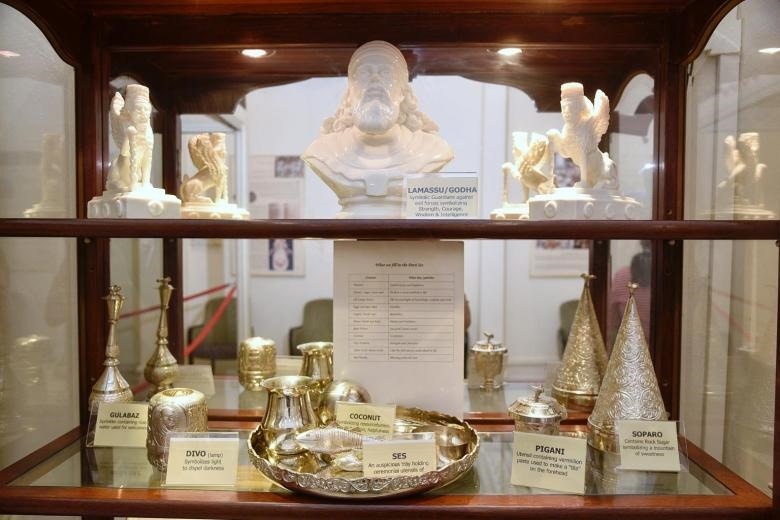Singaporeans now have a chance to learn more about the Parsi community, numbering about 350 here, with the opening of a museum on Monday (March 14).
Based in Zoroastrian House in Desker Road in Rochor, it is a showcase of the Parsis’ history, traditions and Zoroastrianism, one of 10 recognised religions here.
Article by Clement Yong | The Straits Times
The two-floor permanent exhibition, titled The Joyous Flame, tells its story mostly through illustrated panels. There are some objects that the Parsis use in their everyday life – a silver fish decorative object used to store sugar, and apparel worn during the Navjote ceremony, an initiation service for children aged between seven and nine, are highlights.
Originating from ancient Persia, the Parsis fled to western India in the seventh century to avoid religious persecution. They trace their history in Singapore back to Mr Muncherjee, a supposed convict who was the first Parsi in recorded history to arrive here 200 years ago.
“We have never had this (museum) before, but as our numbers grew in the last few decades, the need was increasingly felt,” said Parsi Zoroastrian Association of South East Asia (PZAS) president Homiyar Vasania.
“We also felt this was important for our own community members to know more about their history and culture. We consider ourselves an important intangible culture heritage in Singapore, and hope this museum is an important window to look into and understand us.”
The exhibition is co-curated by PZAS with the Parzor Foundation, a not-for-profit organisation that focuses on Parsi-Zoroastrianism heritage.
Since the first Parsis arrived, the community has become a wealthy and influential segment of society despite their small number.
They are well known for their philanthropy and business activities. Among the most notable Parsis in Singapore are entrepreneur Navroji Mistri, who donated $1 million to build Singapore General Hospital’s children wing in 1952, and the Cursetjees.
The latter were the original partners of John Little, who set up the now defunct but well-known department store of the same name here.
Mr Homiyar said many schools, museums, organisations and researchers have approached PZAS, headquartered here, to learn more about the Parsis and their traditions in recent years, and work began on the museum a few months before Covid-19 started.
The community faces a continued struggle to maintain a “critical mass” in numbers, he added.
For instance, it has no full-time priest for religious activities and there is no Zoroastrian fire temple in Singapore, unlike in India where flames – representing Ahura Mazda, their supreme deity – are kept burning 24/7.
Zoroastrianism is the world’s oldest monotheistic religion, and was among the first historically to preach concepts like heaven, hell, angels and demons.
Its prophet and founder, Zarathustra, began teaching Zoroastrian tenets some time between the 18th and 16th century BC, and has become a widely studied figure for students of religion, history and philosophy.
Perhaps Zoroastrians’ most well-known practice is the Tower of Silence, where their human dead is placed in an open circular, raised structure and exposed to the elements and carrion birds in a process of decay that they believe avoids contaminating the soil.
Three Parsis embroidered fabric border which are a unique part of India’s diverse textile heritage. ST PHOTO: DESMOND WEE
They also claim the oldest human rights charter, the Cyrus Cylinder, placed by Persian king Cyrus the Great in Babylon after he captured the city in the 6th century BC.
It states that “I freed its citizens from the yoke of servitude, I allowed no one to harass or terrorise, I set them free to worship their gods whose abodes I raised from ruins”.
The original is now held in the British Museum and its message of freedom of religion and tolerance has led to the display of a replica at the United Nations’ headquarters in New York.
A replica scale model of a Dokhmenashini, a system of sky burials that relies on the sun and carrion birds to dispose of bodies. ST PHOTO: DESMOND WEE
Minister for Culture, Community and Youth Edwin Tong was at the opening ceremony on Monday, and said the Parsis are a very important part of Singapore.
“Despite relatively small numbers, the Parsi community has always been an active participant in Singapore’s rich social fabric. It is a community both of deep roots and tall branches.”
He added that the museum will open the Parsi community up to the rest of Singaporeans. “Understanding and knowing is the first step to accepting (a different culture) which then becomes embracing and being a part of,” he noted.
Entry to the museum is free but visitors are advised to make an appointment with PZAS at pzas.singapore@gmail.com before going.

